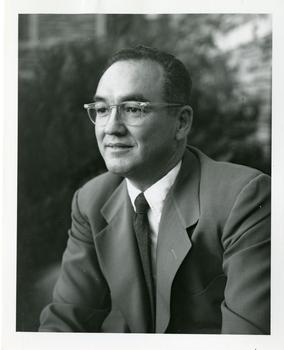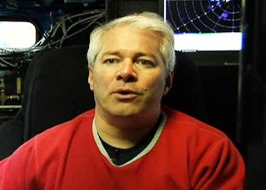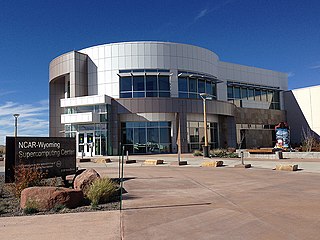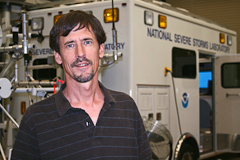The University Corporation for Atmospheric Research (UCAR) is a US nonprofit consortium of more than 100 colleges and universities providing research and training in the atmospheric and related sciences. UCAR manages the National Center for Atmospheric Research (NCAR) and provides additional services to strengthen and support research and education through its community programs. Its headquarters, in Boulder, Colorado, include NCAR's Mesa Laboratory, designed by I.M. Pei.

The US National Center for Atmospheric Research is a US federally funded research and development center (FFRDC) managed by the nonprofit University Corporation for Atmospheric Research (UCAR) and funded by the National Science Foundation (NSF). NCAR has multiple facilities, including the I. M. Pei-designed Mesa Laboratory headquarters in Boulder, Colorado. Studies include meteorology, climate science, atmospheric chemistry, solar-terrestrial interactions, environmental and societal impacts.

Walter Orr Roberts was an American astronomer and atmospheric physicist, as well as an educator, philanthropist, and builder. He founded the National Center for Atmospheric Research and took a personal research interest for many years in the study of influences of the Sun on weather and climate.
The High Altitude Observatory (HAO) conducts research and provides support and facilities for the solar-terrestrial physics research community in the areas of solar and heliospheric physics, and the effects of solar variability on the Earth's magnetosphere, ionosphere, and upper atmosphere.

Joshua Michael Aaron Ryder Wurman is an American atmospheric scientist and inventor noted for tornado, tropical cyclone, and weather radar research.

The Verification of the Origins of Rotation in Tornadoes Experiment are field experiments that study tornadoes. VORTEX1 was the first time scientists completely researched the entire evolution of a tornado with an array of instrumentation, enabling a greater understanding of the processes involved with tornadogenesis. A violent tornado near Union City, Oklahoma was documented in its entirety by chasers of the Tornado Intercept Project (TIP) in 1973. Their visual observations led to advancement in understanding of tornado structure and life cycles.

Warren Morton Washington is an American atmospheric scientist, a former chair of the National Science Board, and currently a Distinguished Scholar at the National Center for Atmospheric Research (NCAR) in Boulder, Colorado.

David Atlas was an American meteorologist and one of the pioneers of radar meteorology. His career extended from World War II to his death: he worked for the US Air Force, then was professor at the University of Chicago and National Center for Atmospheric Research (NCAR), researcher at NASA and private consultant. Atlas owned 22 patents, published more than 260 papers, was a member of many associations, and received numerous honors in his field.

The NCAR-Wyoming Supercomputing Center (NWSC) is a high-performance computing (HPC) and data archival facility located in Cheyenne, Wyoming, that provides advanced computing services to researchers in the Earth system sciences.

Erik Nels Rasmussen is an American meteorologist and leading expert on mesoscale meteorology, severe convective storms, forecasting of storms, and tornadogenesis. He was the field coordinator of the first of the VORTEX projects in 1994-1995 and a lead principal investigator for VORTEX2 from 2009-2010 and VORTEX-SE from 2016-2017, as well as involved in other smaller VORTEX offshoots and many field projects.

Paul M. Markowski is an American meteorologist and leading expert on tornadogenesis and the forecasting of supercells and tornadoes.
Jeffrey W. Frame is an American atmospheric scientist known for observational and modeling studies of severe convective storms and for teaching meteorology. He was a scientist for VORTEX2 and other field research programs.
Yvette Richardson is an American meteorologist with substantial contributions on tornado dynamics, tornadogenesis, the environments of tornadoes, supercells, and severe convection, and radar observations of these. She was a principal investigator (PI) of VORTEX2.

Timothy Laurence Killeen is a British and American geophysicist, space scientist, professor, and university administrator. Killeen took office as the president of the University of Illinois system in 2015. He has been the principal investigator on research projects for NASA and the National Science Foundation. Killeen has authored more than 150 publications in peer-reviewed journals as well as more than 300 other publications and papers. He has served on various White House committees and task forces and is a past editor-in-chief of the Journal of Atmospheric and Solar-Terrestrial Physics.
Francis Patton Bretherton was an applied mathematician and a professor emeritus of the Department of Atmospheric and Oceanic Sciences at the University of Wisconsin, Madison.
Richard A. Anthes was a long time president of the University Corporation for Atmospheric Research. The Anthes Building in Boulder, Colorado, is the first UCAR-owned building to be named for an eminent scientist – and a living one at that.” His area of study at the University of Wisconsin, Madison, focused on hurricanes and tropical cyclones. Dr. Anthes taught as a professor for ten years at Pennsylvania State University before accepting a position at the National Center for Atmospheric Research as director of the Atmospheric and Prediction Division in 1981, a position he kept until 1986 when he became director of NCAR. In 1988, he started working as president of UCAR, and retired from that position in 2012. During his presidency at UCAR, he participated or chaired over forty different national committees for agencies such as NASA, NSF, and NOAA. He also established a program aimed at increasing participation in the atmospheric sciences called SOARS .

Robert A. Houze, Jr., is an American atmospheric scientist, researcher, author, and Professor Emeritus of Atmospheric Sciences at the University of Washington where he led a research team known as the Mesoscale Group for 46 years. He and his group participated in international field projects around the world and global satellite programs employing weather radar and aircraft in the tropics and midlatitudes, in projects sponsored by NSF, NASA, DOE, and NOAA. Houze has been on the science teams for three NASA satellites for the global study of clouds and precipitation. The predominant areas of his research are tropical convective clouds, extreme storms, flooding in the Asian Monsoon, tropical cyclones, and midlatitude frontal systems in mountainous regions.

Everette Joseph is an American atmospheric scientist who serves as the director of the National Center for Atmospheric Research (NCAR) in Boulder, Colorado.

James F. "Jeff" Kimpel was an American atmospheric scientist with expertise on severe storms who was a provost of the University of Oklahoma (OU) and director of the National Severe Storms Laboratory (NSSL).

Project NIMROD was a meteorological field study of severe thunderstorms and their damaging winds conducted by the National Center for Atmospheric Research (NCAR). It took place in the Greater Chicago area from May 15 to June 30, 1978. Data collected was from single cell thunderstorms as well as mesoscale convective systems, such as bow echoes. Using Doppler weather radars and damage clues on the ground, the team studied mesocyclones, downbursts and gust fronts. NIMROD was the first time that microbursts, very localized strong downdrafts under thunderstorms, were detected; this helped improve airport and public safety by the development of systems like the Terminal Doppler Weather Radar and the Low-level windshear alert system.














